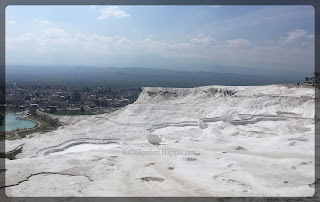Around 1pm we reached the hot springs, ironically, the glacial looking formations are flowing with hot water! I couldn't say it any better myself, "the surreal, brilliant white travertine terraces and warm, limpid pools of Pamukkale hang, like the petrified cascade of a mighty waterfall, from the rim of a steep valley side in Turkey’s picturesque southwest. Truly spectacular in its own right, the geological phenomenon that is Pamukkale, literally "Cotton Castle" in Turkish, is also the site of the remarkably well-preserved ruins of the Greek-Roman city of Hierapolis. With such a unique combination of natural and man-made wonders it’s little wonder that Pamukkale-Hierapolis has been made a Unesco World Heritage site."
I didn't quite understand how it was created, but it seems that, "when the water, supersaturated with calcium carbonate, reaches the surface, carbon dioxide de-gasses from it, and calcium carbonate is deposited. Calcium carbonate is deposited by the water as a soft gel which eventually crystallizes into travertine." All the hotels in the area use water from the hot springs so that the tourists have thermal spas, but this means there isn't quite enough water for the Cotton Castle anymore. Serdar relayed that during the dry months they change the direction of the water so that it keeps everything wet, which in turn keeps everything white.
After wading around in the pools I headed into the thermal spa and food court to get some lunch. A woman there makes a local dish called "Village Bread" and it was simple, but tasty. It's a thin, crepe-like crust filled with potatoes, some spinach, and some cheese.
The thermal spa still has the original Roman columns, now lying prostrate in the pool. Since we still had some time before we were to meet up and begin our walk through the Necropolis, I decided to make the trek up the hill to see the remains of the theater. From the bottom of the hill, viewing the back-side it did not look that impressive, but man was that view misleading!
Much like the facade of the library in Ephesus, the view of the valley behind the stage made the effect quite breathtaking (yes, that may have partially been due to the hike up the hill). You were not allowed down on the ground level, you could only walk part-way down the stadium, but it was incredible. Although I couldn't see it up close, "the theatre, which dates from the time of Severus, is decorated with an admirable frieze depicting a ritual procession and a sacrifice to the Ephesian Artemis."
At 3pm we started our walk through the ruins, and eventually through the Necropolis, back to the bus. "Necropolis" is Greek for "city of dead", the site is the cemetery of the city of Hierapolis. Hierapolis was established by the the kings of Pergamon at the end of the 2nd century B.C. The cemetery extends a little over a mile, and I think Serdar told us it is the largest one in Asia Minor.
It was cold and windy, but thanks to the brilliant sunshine bestowing its beams on us all day the wind was much more bearable. The sepulchers and tombs were quite interesting (according to the UNESCO website the necropolis "affords a vast panorama of the funerary practices of the Greco-Roman era"), but the fresh, green grass, dotted with bright red poppies and little yellow flowers, all around the pale stone remains made the area very picturesque. We saw four different types of graves from various time periods, including Tumulus, Sarcophagus, Public, and Family.
Our hotel for the evening was the Doga Thermal Health Spa, so we all enjoyed the thermal spas and swimming pools before dinner.
The dessert displays at every hotel are jaw-dropping, and no matter where we stay the food is so good (not that I'm incredibly picky, mind you). This evening they had a special dessert called Tulumba. It's a fried dough dipped in a sweet (probably honey-based since they seem to make anything into a dessert by soaking it in honey) sauce. I would describe it as a cross between a donut and a churro (minus the cinnamon). I learned later that they are sometimes referred to as Turkish Churros. While they were tasty, I much preferred the baclava assortment.










No comments:
Post a Comment